Difference between revisions of "Thermistor"
(→Key Stage 4) |
|||
| Line 12: | Line 12: | ||
===IV Graph=== | ===IV Graph=== | ||
{| class="wikitable" | {| class="wikitable" | ||
| − | |[[File:IVGraphThermistor.png|center| | + | |[[File:IVGraphThermistor.png|center|400px]] |
|} | |} | ||
Revision as of 15:01, 28 February 2019
Contents
Key Stage 4
Meaning
A thermistor is a resistor which changes resistance depending on the temperature.
About Thermistors
- 'NTC' thermistors decrease resistance as the temperature increases. (NTC = Negative Temperature Coefficient.)
- A thermistor can be used to control the current passing through a circuit. If the potential difference is constant then the current decreases as temperature decreases.
- A thermistor can be used to control the potential difference of another component in series with it. If the temperature is decreased then the potential difference across other components will decrease.
- Thermistors can be used temperature sensors.
IV Graph
Description
The IV graph for an 'NTC' thermistor shows that:
- At a high temperature the current increases rapidly with the potential difference
- At a low temperature the current increases slowly with the potential difference.
Explanation
- The resistance of an 'NTC' thermistor increases as the temperature decreases.

